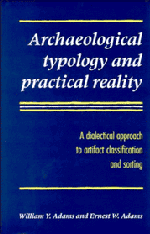 Archaeological Typology and Practical Reality
Archaeological Typology and Practical Reality Book contents
- Frontmatter
- Contents
- List of figures
- List of tables
- The archaeologist's preface
- The philosopher's preface
- PART I Introductory
- PART II The nature of types and typologies
- PART III Typology in action: the Medieval Nubian Pottery Typology
- PART IV Pragmatics of archaeological typology
- 13 The starting point: purpose
- 14 The determinants of types: variables and attributes
- 15 The making of types: formulation, designation and description
- 16 The use of types: typing and sorting
- 17 The ordering of types: taxonomy and seriation
- 18 Variation and variability in archaeological classifications
- 19 The bottom line: practicality
- 20 Principles of practical typology
- 21 Information-theoretic formulations
- PART V Classification, explanation, and theory
- Appendices
- References
- Index
19 - The bottom line: practicality
Published online by Cambridge University Press: 23 November 2009
- Frontmatter
- Contents
- List of figures
- List of tables
- The archaeologist's preface
- The philosopher's preface
- PART I Introductory
- PART II The nature of types and typologies
- PART III Typology in action: the Medieval Nubian Pottery Typology
- PART IV Pragmatics of archaeological typology
- 13 The starting point: purpose
- 14 The determinants of types: variables and attributes
- 15 The making of types: formulation, designation and description
- 16 The use of types: typing and sorting
- 17 The ordering of types: taxonomy and seriation
- 18 Variation and variability in archaeological classifications
- 19 The bottom line: practicality
- 20 Principles of practical typology
- 21 Information-theoretic formulations
- PART V Classification, explanation, and theory
- Appendices
- References
- Index
Summary
In the affluent 1960s and 1970s, archaeological procedures were not always closely scrutinized for their practicality or utility. However, this was an exceptional era in archaeology, one that gave researchers the unaccustomed luxury of experimenting with field and laboratory techniques whose practical value was often undetermined. In more normal times, archaeological research is usually carried out under conditions of severe financial and resource constraint. Considerations of practicality and cost-effectiveness can rarely be ignored, and must sometimes be paramount. We (or our funding agencies) are usually obliged to ask: Do our analytical procedures really tell us more than is intuitively obvious? Does increased rigor lead to measurably more useful or meaningful results? Could the same results be obtained by cheaper or less time-consuming means? Can we justify our procedures not only in terms of what we want to know, but why we want to know it? Above all, is our work likely to diminish the unknown, or merely (perhaps for the nth time), to reconfirm what is already known (see WYA 1960: 19)?
In this chapter we will be considering the issue of practical utility with specific reference to archaeological classifications and their use. In theory, two separate issues are involved here: those of practicality and of utility. Practicality refers to whether a procedure is inherently doable (feasible) and/or affordable. Utility refers to whether the results are of any use. Taken together, “practical utility” refers to whether the cost of any procedure, in time and money, is justified by the results.
- Type
- Chapter
- Information
- Archaeological Typology and Practical RealityA Dialectical Approach to Artifact Classification and Sorting, pp. 233 - 238Publisher: Cambridge University PressPrint publication year: 1991


